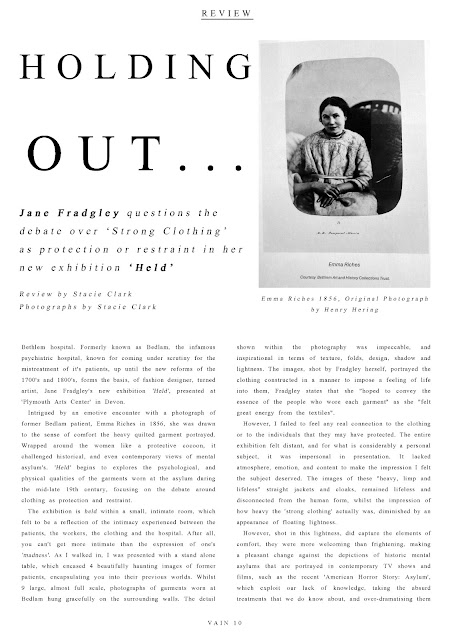Bethlem
hospital. Formerly known as Bedlam, the infamous psychiatric
hospital, known for coming under scrutiny for the mistreatment of
it's patients, up until the new reforms of the 1700's and 1800's,
forms the basis, of fashion designer, turned artist, Jane Fradgley's
new exhibition 'Held', presented at 'Plymouth Arts Center' in Devon.
Intrigued
by an emotive encounter with a photograph of former Bedlam patient,
Emma Riches in 1856, she was drawn to the sense of comfort the heavy
quilted garment portrayed. Wrapped around the women like a protective
cocoon, it challenged historical, and even contemporary views of
mental asylum's. 'Held'
begins to explores the psychological, and physical qualities of the
garments worn at the asylum during the mid-late 19th century,
focusing on the debate around clothing as protection and restraint.
The
exhibition is held
within a small,
intimate room, which felt to be a reflection of the intimacy
experienced between the patiences, the workers, the clothing and the
hospital. After all, you can't get more intimate than the expression
of one's 'madness'.
As I walked in, I was presented with a stand alone table, which
encased 4 beautifully haunting images of former patients,
encapsulating you into their previous worlds. Whilst 9 large, almost
full scale photographs of garments worn at Bedlam hung gracefully on
the surrounding walls. The detail shown within the photography was
impeccable, and inspirational in terms of texture, folds, design,
shadow and lightness. The images, shot by Fradgley herself, portrayed
the clothing constructed in a manner to impose a feeling of life into
them, Fradgley states that she "hoped to convey the essence of
the people who wore each garment" as she "felt great energy
from the textiles".
However, I
failed to feel any
real connection to the clothing or to the individuals that they may
have protected. The entire exhibition felt distant, and for what is
considerably a personal subject, it was impersonal in presentation.
It lacked atmosphere, emotion, and content to make the impression I
felt the subject deserved. The images of these "heavy, limp and
lifeless" straight jackets and cloaks, remained lifeless and
disconnected from the human form, whilst the impression of how heavy
the 'strong clothing' actually was, diminished by an appearance of
floating lightness.
However,
shot in this lightness, did capture the elements of comfort, they
were more welcoming than frightening, making a pleasant change
against the depictions of historic mental asylums that are portrayed
in contemporary TV shows and films, such as the recent 'American
Horror Story: Asylum', which exploit our lack of knowledge, taking
the absurd treatments that we do know about, and over-dramatising
them into acts of terror.
The text
that accompanied the 4 photograph's of former patient’s, shed
positive light on the use of restraint and 'strong' clothing for
providing “more freedom than alternative measures...including
sedation and incarceration in a padded room.” allowing patients to
socialise whilst protecting them from their own harm, such as clothes
ripping, and quilted
gloves to prevent self-harm. Therefore leaving you to ponder that
these horrific and 'inhumane' looking garments, are actually the very
tools needed to help, protect and save, those people.
When
looking at the exhibition from this alternative perspective, I can
only praise Jane Fradgley in successfully achieving her mission of
intent. Her contribution to argue the debate of protection and
restraint in clothing has certainly opened my eyes and challenged my
own preconceptions, that the garments caused further mental distress
and a sense of imprisonment for the patients. But as 'Held' suggests,
they were in fact designed to care and to comfort them.
Unfortunately
though, it suffered poor curatorship, and lack of substance to really
evoke a strong emotional response. For an exhibition based on the
garments themselves, I would have liked to have seen at least one
piece of clothing on display, to really emphasis the point.



No comments:
Post a Comment